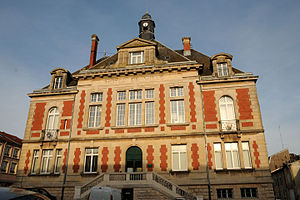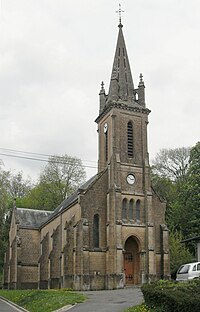Stenay
| Stenay | ||
|---|---|---|

|
|
|
| region | Grand Est | |
| Department | Meuse | |
| Arrondissement | Verdun | |
| Canton | Stenay (main town) | |
| Community association | Pays de Stenay et du Val Dunois | |
| Coordinates | 49 ° 29 ' N , 5 ° 11' E | |
| height | 163-303 m | |
| surface | 27.16 km 2 | |
| Residents | 2,597 (January 1, 2017) | |
| Population density | 96 inhabitants / km 2 | |
| Post Code | 55700 | |
| INSEE code | 55502 | |
| Website | http://www.stenay.fr/ | |
 Stenay, Hôtel de ville (Town Hall) |
||
Stenay is a French commune in the Meuse department in the region of Grand Est (2015 Lorraine ).
geography
The municipality of Stenay, with 2597 inhabitants (as of January 1, 2017) covers an area of around 27 square kilometers. It is located on the edge of the Ardennes on the banks of the Meuse (French: Meuse ) in a traditional French-speaking area. The place is also accessed by the canal Canal de la Meuse ( formerly: Canal de l'Est, branche Nord ), which is formed by the canalized Meuse. A small tributary of the Meuse, the Wiseppe , also flows here .
Neighboring municipalities of Stenay are Martincourt-sur-Meuse in the north, Olizy-sur-Chiers , Nepvant and Brouennes in the northeast, Baâlon in the east, Mouzay in the southeast, Saulmory-Villefranche in the south, Wiseppe in the southwest, Laneuville-sur-Meuse in the west as well Cesse in the northwest.
history
A settlement already existed at the time of the Roman Empire around 50 BC. On December 23, 679, the Merovingian king Dagobert II was murdered near Stenay , who was then buried in a local monastery.
After the Peace of Paris of 1815, when the troops of Napoleon's opposing parties were to remain in France for five years, the head of the 3rd Brigade, the Prussian Major General Gustav Xaver Reinhold von Ryssel, moved into the headquarters in Stenay. He commanded the 9th Infantry Regiment (Colbergisches), the 16th Infantry Regiment (3rd Westphälisches) and the 5th Dragoon Regiment (Brandenburgisches) as well as the six-pound mounted battery No. 13.
Stenay is the birthplace of the British envoy Louis Cavagnari, who was murdered in Kabul in 1879 .
During the First World War, the German Crown Prince Wilhelm set up his headquarters in the castle of the Verdier family. From September 1914 to February 1918 he stayed there as commander of Army High Command 5 with his staff. On November 11, 1918, a few hours before the armistice came into force, the city was occupied by the 89th Infantry Division of the USA, with heavy losses from the anti-artillery fire of the German troops.
Population development
| year | 1962 | 1968 | 1975 | 1982 | 1990 | 1999 | 2009 | 2016 |
| Residents | 3829 | 4125 | 3767 | 3693 | 3202 | 2952 | 2768 | 2673 |
Attractions
- Musée Européen de la Bière (European Beer Museum)
- Church of St. Joseph in the district of Cervisy
- Chapelle Saint-Lambert de Cervisy in the district of Cervisy from the 12th and 13th centuries ( Monument historique )
Twin cities
- Münnerstadt (Germany)
literature
- Le Patrimoine des Communes de la Meuse. Flohic Editions, Volume 2, Paris 1999, ISBN 2-84234-074-4 , pp. 960-972.
Web links
Individual evidence
- ^ Karl von Damitz: History of the campaign of 1815 in the Netherlands and France. Second part. Berlin / Posen / Bromberg 1838. p. 419.

